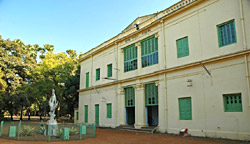On 27 November,1888, Mrinalini gave birth to another child (male), Rathindranath.
Rabindranath's young family was at the centre of his life. He was deeply upset at having to leave them in order to go to England in August 1890. A letter that he wrote to his wife from the ship stated that he felt his spirit left his body to come and see her. His eldest daughter Madhurilata was four at that time and his eldest son Rathi was two. He returned to home from England in November 1890. But he could not take his family with him when he first went to live in Shelidah on Zamindari work since their house was not yet built. He lived in the old family house boat called the Padmaboat.
He sent his wife and children to Sholapur in Maharashtra where Satyendranath was posted at that time.
He wrote very frequently to his wife and, as his letters show, he waited anxiously and longingly for her reply.
The concerns he was sharing were about their togetherness, her happiness, his life, their children's future, and the marriages of their daughters. Both Bela and his second daughter Renuka or Rani were married in 1901, with one month's gap, when they were fouteen and twelve years old, respectively. He worried especially about Rani's ability to make the transition. He wrote,
Bird's build their nests with straw. It matters little to them to leave their homes and go. But we build ours with our minds . That becomes an invisible shelter in all that we do, in our work, our reading and writing , our thinking. Just as a cart makes grooves on its journey which we can feel in the swaying of our bodies, a mind involuntarily settles into the grooves it makes with the mind's eye, and we don't want to get out of them even when there is occasion for it.
Attempt was being made to get his book 'Rajarshi' in the list of approved books for schools.
Rabindranath's young family was at the centre of his life. He was deeply upset at having to leave them in order to go to England in August 1890. A letter that he wrote to his wife from the ship stated that he felt his spirit left his body to come and see her. His eldest daughter Madhurilata was four at that time and his eldest son Rathi was two. He returned to home from England in November 1890. But he could not take his family with him when he first went to live in Shelidah on Zamindari work since their house was not yet built. He lived in the old family house boat called the Padmaboat.
He sent his wife and children to Sholapur in Maharashtra where Satyendranath was posted at that time.
He wrote very frequently to his wife and, as his letters show, he waited anxiously and longingly for her reply.
The concerns he was sharing were about their togetherness, her happiness, his life, their children's future, and the marriages of their daughters. Both Bela and his second daughter Renuka or Rani were married in 1901, with one month's gap, when they were fouteen and twelve years old, respectively. He worried especially about Rani's ability to make the transition. He wrote,
Bird's build their nests with straw. It matters little to them to leave their homes and go. But we build ours with our minds . That becomes an invisible shelter in all that we do, in our work, our reading and writing , our thinking. Just as a cart makes grooves on its journey which we can feel in the swaying of our bodies, a mind involuntarily settles into the grooves it makes with the mind's eye, and we don't want to get out of them even when there is occasion for it.
Attempt was being made to get his book 'Rajarshi' in the list of approved books for schools.













